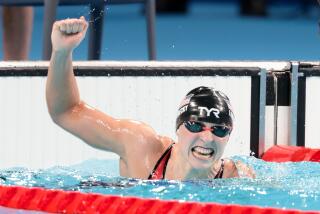Because It’s There : Lake Titicaca Is So Cold It Sends Chills to the Muscles and Has Something That Leaves Swimmers With Bites; So, of Course, It’s Ideal for Lynne Cox
- Share via
The world’s highest navigable lake lies 12,507 feet high in the Andes on the border between Bolivia and Peru, 110 miles long and 45 miles wide. The Incas named it Titicaca--”the mountain cat and the rock” in their Quechua language--because, according to NASA satellite photos and active imaginations, the shape of the lake resembles a big cat playing with a rock.
But how did they know that?
The sacred and mysterious land of the Incas partly inspired Erich von Daeniken’s 1970s best-seller, “Chariots of the Gods,” which speculated about ancient astronauts. Lynne Cox, one of the world’s most ambitious swimmers, went there hoping to unravel more mundane mysteries involved in her avocation: swimming where no one has swum before.
At Titicaca, she soon learned why they hadn’t.
The Bering Strait, the Nile, Siberia’s Lake Baikal, New Zealand’s Cooke Strait, the shark-infested Cape of Good Hope, the Beagle Channel at the tip of South America, even a week of high-altitude training in Colorado--none of that prepared her for Titicaca.
Cox, 35, of Los Alamitos, swam on May 26, crossing about 10 miles from near the resort village of Copacabana in Bolivia to the native village of Chimbo in Peru, in 3 hours 48 minutes.
“It was a lot warmer than the Bering Strait--56 to 58 (degrees),” she said. “But because of the altitude, the cold is more intense and more rapid. At the Bering Strait (38 to 44 degrees) you could keep it out at skin level. At that (Titicaca) altitude it seemed to go right down into the muscles.
“When you get into cold water, it takes your breath away. On my first training swim I got in real slowly to get used to it. After 15 minutes of swimming I suddenly couldn’t breathe.”
Cox was taken aback, thinking, “ ‘Oh, no, this isn’t going to work.’ To be able to do all these different things all around the world and then be limited so quickly in a training swim was startling . . . really frustrating because it felt so terribly human. ‘How am I even going to make a mile?’ ”
Worse, that night she started itching. The next morning she discovered dozens of bites.
“Like enormous mosquito bites,” she said. “Initially they’d be the size of a quarter, and when you started scratching them they’d welt up.
“What bit me? I couldn’t figure it out. That made it really hard to go back in. I woke up the following morning with more bites, all over--everywhere.”
Her apprehension mounted.
“Getting into the water--and it was cold the entire time--and feeling it was in the muscles instead of the skin--that was hard training. But knowing that each day I’d come out with more bites, that was really hard.
“I thought swimming at 12,500 feet would be challenging, but I didn’t expect it to be as challenging. Just getting used to trying to breathe at that altitude, getting used to the water and then facing whatever was in the water. . . . “
And she never did find out what was biting her.
The logistics of Cox’s swims in remote, primitive places are always complex, and no matter what arrangements she makes, she usually has to redo them all at the last minute. Escort boats always seem to be a problem.
“Always it’s the boats,” she said. “Are you going to get the boats? Who knows the conditions of the lake?”
This time she was helped by Robert Gelbard, the former ambassador to Bolivia who is now assistant secretary of state for inter-American affairs. Gelbard contacted an admiral in the Bolivian navy. Bolivia is a land-locked country, but it still has a navy. Capt. Abel Coa had told Cox that one boat would be enough. Then the admiral gave Cox a note for the captain.
“I handed it to Capt. Coa,” Cox said. “He read it--and stood at attention. ‘What do you need?’ ‘I need two boats--one that will be like a guide right beside me and one in front to navigate off, and also as a backup boat.’ ”
On the morning of the swim, the two boats were there--and good thing.
“Within 15 or 20 yards of shore the boat (Capt. Coa) was on, the motor stopped and they couldn’t get it going,” Cox said.
Earlier, there had been a frustrating delay. “I wanted to get going on time, because the longer you wait the more the wind comes up,” Cox said. “ ‘Why are we waiting?’ The captain kept saying, ‘A few more minutes, a few more minutes.’ Then at 7:25 or so this woman comes down half-dressed. Turns out she’s the captain’s wife, who wanted to meet me and wish me well.”
She started at a peninsula called “The Mouth of the Frog.”
“We found out later that’s the place in the lake where the most drownings occur, because of the currents.”
But the water was so clear that she could see 40 or 50 feet.
“During training I’d look down and see all these different frogs. In some areas (there were) spotted frogs a foot and a half long.”
Cox’s support team included Barry Binder, a Los Alamitos realtor; Debra Ford, a Hollywood clothing designer; Pete Kelly, a San Luis Obispo restaurateur; Maria Sullivan, a teacher, and Jose Cabada, owner of the monthly Peruvian newspaper “Peru of the ‘90s” published in Laguna Niguel--a typically strange but intense coterie for one of Cox’s swims.
“They were staring . . . watching me with smiling concern all the way across, willing me across.
“Usually on a long swim you start hitting the wall two or three hours into the swim. On this swim I started feeling that fatigue after 20 or 30 minutes. The lactic acid was building up in my muscles. Everything was changed.”
Because dehydration is faster at high altitude, she drank a 16-ounce bottle of Gatorade before she started, then stopped every half-hour for Gatorade or apple juice, her usual staple because of its high sugar content.
She also had a healthy breakfast of quinoa, a high-protein, oatmeal-like cereal popular in the area.
She figured, “If it powered an Inca nation, maybe it would work for a long-distance swim.”
When it mattered, she said: “Everyone was so well organized. . . . The Bolivian navy brought on an Aymaran fisherman who knew the lake really well. He kept us right on course the entire time.
“Instead of breathing my normal three to five strokes, I decided I’d breathe every two strokes. But it wasn’t enough because 20 to 30 minutes into the swim I was already sore. I had to back off but also maintain a pace, because you have to generate enough heat to stay warm or you’ll go into hypothermia.
“At 20 or 30 minutes, there was the wall, and I think I slowed down a little. They were monitoring my stroke rate every half-hour. It was between 58 and 63. In a normal swim my rate is 65 to 70.
“Then I hit another wall . . . maybe nine times where ‘This is really hard. I want to stop and rest.’ But you couldn’t, because then you’d get cold, and that would make it harder.”
As Cox approached the Peruvian shore, she saw men and women working in the fields. They turned to watch--dumbfounded.
“We had all these people coming down to greet us, coming out of the fields,” she said. “Their sheep were behind them. But they stood a distance away, and they didn’t know what to say, and I didn’t know what to say.”
Cabada took charge, speaking to the people in their Aymaran language.
“It was like an alien had landed,” he said later. “Nobody swims in that lake, and for her to come out of nowhere. . . . They just stood there looking, even when she came up onto the beach. These people are very shy. They don’t see many outsiders. I had to tell them, ‘Come, it is all right. This is a great thing she has done. This woman’s come all this way to do this, so greet her.’ ”
Cox said: “He’d cheer, and they’d cheer, ‘Viva Peru!’ And they’re all going ‘Viva Peru!’ And he had the head guy come over and meet me, and then all the men first, and then the women. This older woman touched my hand, and people were hugging me. It was human contact--the part where, that’s why you do it.”
Usually, as Cox cools down after a swim, she starts to shiver--the first stage of hypothermia, which can lead to convulsions.
“Because I was so high, I was shivering and breathing harder sitting down, trying to rewarm, than when I was actually swimming,” she said. “Very strange. That lasted for an hour and a half.”
Cabada said: “Nobody thought she could do it. ‘The water is too cold. She will freeze to death.’ The chance they gave her was about a thousand to one.”
More to Read
Sign up for The Wild
We’ll help you find the best places to hike, bike and run, as well as the perfect silent spots for meditation and yoga.
You may occasionally receive promotional content from the Los Angeles Times.






